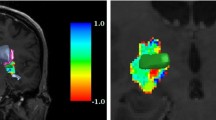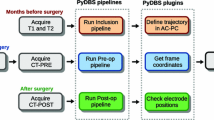Abstract
Purpose
Microelectrode recordings (MERs) are a significant clinical indicator for sweet spots identification of implanted electrodes during deep brain stimulation of the subthalamic nucleus (STN) surgery. As 1D MERs signals have the unboundedness, large-range, large-amount and time-dependent characteristics, the purpose of this study is to propose an automatic and precise identification method of sweet spots from MERs, reducing the time-consuming and labor-intensive human annotations.
Methods
We propose an automatic identification method of sweet spots from MERs for electrodes implantation in STN-DBS. To better imitate the surgeons’ observation and obtain more intuitive contextual information, we first employ the 2D Gramian angular summation field (GASF) images generated from MERs data to perform the sweet spots determination for electrodes implantation. Then, we introduce the convolutional block attention module into convolutional neural network (CNN) to identify the 2D GASF images of sweet spots for electrodes implantation.
Results
Experimental results illustrate that the identification result of our method is consistent with the result of doctor’s decision, while our method can achieve the accuracy and precision of 96.72% and 98.97%, respectively, which outperforms state-of-the-art for intraoperative sweet spots determination.
Conclusions
The proposed method is the first time to automatically and accurately identify sweet spots from MERs for electrodes implantation by the combination an advanced time series-to-image encoding way with CBAM-enhanced networks model. Our method can assist neurosurgeons in automatically detecting the most likely locations of sweet spots for electrodes implantation, which can provide an important indicator for target selection while it reduces the localization error of the target during STN-DBS surgery.







Similar content being viewed by others
References
Karamintziou SD, Deligiannis NG, Piallat B, Polosan M, Chabardès S, David O, Stathis PG, Tagaris GA, Boviatsis EJ, Sakas DE, Polychronaki GE, Tsirogiannis GL, Nikita KS (2016) Dominant efficiency of nonregular patterns of subthalamic nucleus deep brain stimulation for Parkinson’s disease and obsessive-compulsive disorder in a data-driven computational model. J Neural Eng 13(1):16013
Gross RE, Krack P, Rodriguez-Oroz MC, Rezai AR, Benabid A (2006) Electrophysiological Mapping for the Implantation of Deep Brain Stimulators for Parkinson’s Disease and Tremor. Movement Disord: official journal of the Movement Disorder Society 21(S14):S259–S283
Michmizos KP, Konstantina SN (2011) Addition of deep brain stimulation signal to a local field potential driven Izhikevich model masks the pathological firing pattern of an STN neuron. In:2011 annual international conference of the IEEE engineering in medicine and biology society, pp 7290–7293
Novak P, Przybyszewski AW, Barborica A, Ravin p, Margolin L, Pilitsis JG, (2011) Localization of the subthalamic nucleus in Parkinson disease using multiunit activity. J Neurol Sci 310(1):44–49
Wang Z, Oates T (2015) Encoding time series as images for visual inspection and classification using tiled convolutional neural networks. In: twenty-ninth AAAI conference on artificial intelligence
Hatami N, Gavet Y, Debayle J (2018) Classification of time-series images using deep convolutional neural networks. In: Tenth international conference on machine vision, pp 106960
Khosravi M, Atashzar SF, Gilmore G, Jog MS, Patel RV (2020) Intraoperative localization of STN during DBS surgery using a data-driven model. IEEE J Transl Eng He 8:1–9
Schiaffino L, Muñoz A, Martínez JG (2016) STN area detection using K-NN classifiers for MER recordings in Parkinson patients during neurostimulator implant surgery. J Phys Conf Series 705(1):12050
Woo S, Park J, Lee JY, Kweon IS (2018) CBAM: convolutional block attention module. In:2018 International proceedings of the European conference on computer vision, pp 3–19
Gao J, Wang Q, Yuan Y (2019) SCAR: spatial-/channel-wise attention regression networks for crowd counting. Neurocomputing 363:1–8
Wang Q, Wu B, Zhu P, Li P, Hu Q (2020) ECA-net: Efficient channel attention for deep convolutional neural networks. In: 2020 Proceedings of the IEEE/CVF conference on computer vision and pattern recognition, pp.11534–11542
Wan KR, Maszczyk T, See AAQ, Dauwels J, King NKK (2019) A review on microelectrode recording selection of features for machine learning in deep brain stimulation surgery for Parkinson’s disease. Clin Neurophysiol 130(1):145–154
Rajpurohit V, Danish SF, Hargreaves EL, Wong S (2015) Optimizing computational feature sets for subthalamic nucleus localization in DBS surgery with feature selection. Clin Neurophysiol 126(5):975–982
Valsky D, Marmor-Levin O, Deffains M, Eitan R, Blackwell KT, Bergman H, Israel Zvi (2016) Stop! border ahead: automatic detection of subthalamic exit during deep brain stimulation surgery. Mov Disord 32(1):70–79
Karthick PA, Wan KR, Qi A, Dauwels J, King N (2020) Automated detection of subthalamic nucleus in deep brain stimulation surgery for parkinson’s disease using microelectrode recordings and wavelet packet features. J Neurosci Meth 343
Wong S, Baltuch GH, Jaggi JL, Danish SF (2009) Functional localization and visualization of the subthalamic nucleus from microelectrode recordings acquired during DBS surgery with unsupervised machine learning. J Neural Eng 6(2):26006
Cardona H, Alvarez MA, Orozco AA (2018) Multi-task learning for subthalamic nucleus identification in deep brain stimulation. Int J Mach Learn Cyb 9(7):1181–1192
Cao L, Li J, Zhou Y, Liu Y, Zhao Y, Liu H (2019) Online identification of functional regions in deep brain stimulation based on an unsupervised random forest with feature selection. J Nenural Eng 16(6)
Kingma DP, Ba J (2015) Adam: a method for stochastic optimization. In: 3rd international conference on learning representations
Ay B, Yildirim O, Talo M, Baloglu UB, Aydin G, Puthankattil SD, Acharya UR (2019) Automated depression detection using deep representation and sequence learning with EEG signals. J Med Syst 43(7):205
Acknowledgements
We gratefully thank the reviewers for their constructive comments. This work was supported in part by Key-Area Research and Development Program of Guangdong Province, China (2020B010165004), in part by Shenzhen Fundamental Research Program (JCYJ20200109110208764, JCYJ20200109110420626), in part by National Natural Science Foundation of China (U1813204, 61802385, 62072468), in part by Natural Science Foundation of Guangdong (2021A1515012604) and in part by the Fundamental Research Funds for the Central Universities, China University of Petroleum (East China) (No.18CX06060A). Weixin Si and Xiaodong Cai are both the corresponding authors of this article. Linxia Xiao and Caizi Li contributed equally to this work.
Author information
Authors and Affiliations
Corresponding author
Ethics declarations
Conflict of interest
The authors declare that they have no conflict of interest.
Additional information
Publisher's Note
Springer Nature remains neutral with regard to jurisdictional claims in published maps and institutional affiliations.
Rights and permissions
About this article
Cite this article
Xiao, L., Li, C., Wang, Y. et al. Automatic identification of sweet spots from MERs for electrodes implantation in STN-DBS. Int J CARS 16, 809–818 (2021). https://doi.org/10.1007/s11548-021-02377-2
Received:
Accepted:
Published:
Issue Date:
DOI: https://doi.org/10.1007/s11548-021-02377-2




